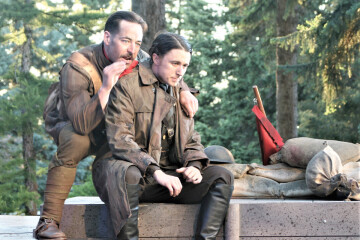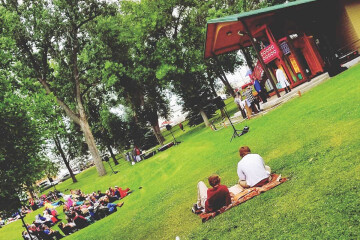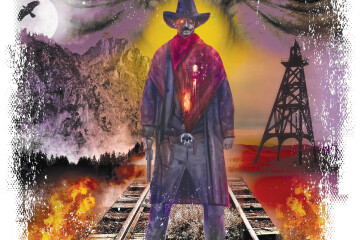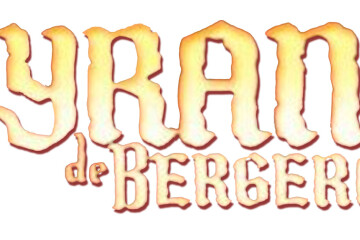Timon of Anaconda
Looking at the Anthropocene through Shakespeare
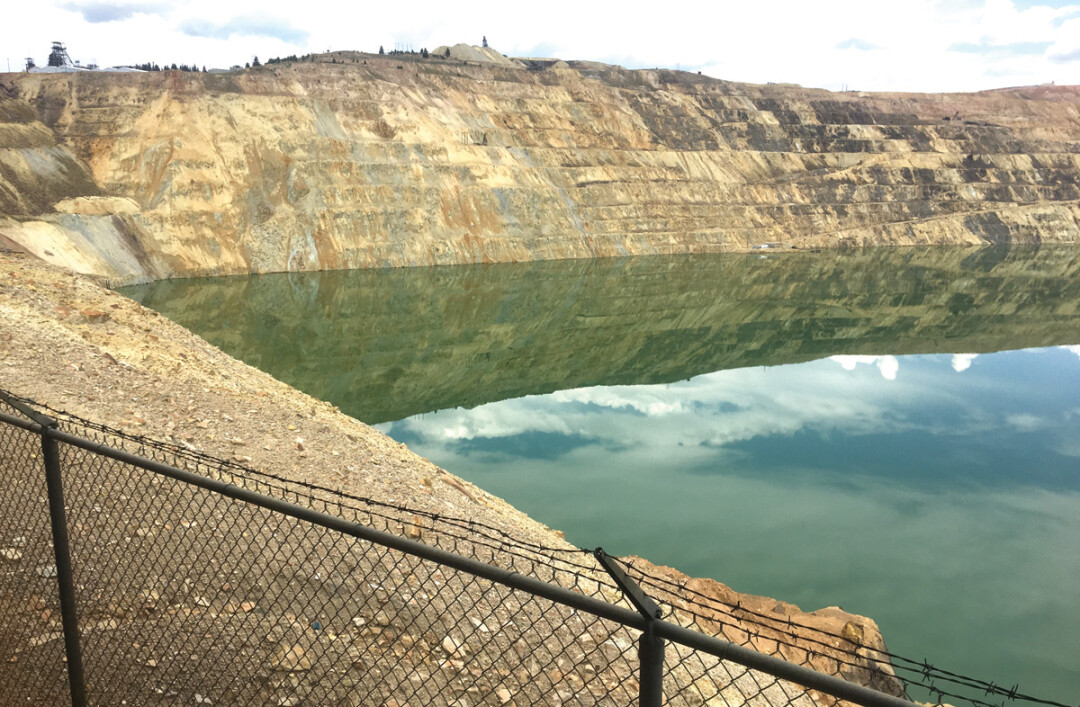
In 1877, a young man named William Clark acquired his first mine in the struggling mining camp of Butte in Montana Territory. Clark went on to become one of the three Copper Kings of Butte, thus one of the richest men in the world at the time. Yet, despite his wealth, Clark constantly searched for fame, power, and more money. Eventually Clark built and donated the Columbia Gardens for the entertainment of the people of Butte, providing a place for plays, dances, rides, and general amusements on the edge of town. By the 1970s, human greed and large-scale open-pit mining swallowed the Gardens, resulting in today’s Berkeley Pit. In 2019, a new adaptation of an old play explores the legacy of a world such as Clark’s, where the quest for precious metals and wealth leaves a hole in the midst of our lives and the planet. This adaptation of William Shakespeare’s Timon of Athens is directed by Dr. Gretchen Minton on September 7th in Bozeman and September 8th in Butte. Minton cut the Timon of Athens script into an 80-minute production titled Timon of Anaconda, modeled after Butte and Anaconda in the 1960s-70s time period, a turbulent time in Butte’s history.
Timon of Athens, one of Shakespeare’s lesser-known plays, is a story of human greed, friendship, loyalty, economic disaster, and environmental degradation. Timon, a very wealthy and generous man, loses his fortune. After his friends refuse his entreaties for assistance he retreats into nature, embittered towards all humanity, convinced he could live from nature alone with no need for people or material things. When he discovers precious metals in the earth as he’s digging for roots to eat, his “friends” come back to him, eager to share in his good luck. Timon now sees the perfidy of human nature and declares himself a misanthrope and has nothing to do with other people.
The question “did Shakespeare really write Shakespeare” has been said so often that it has become a joke. But Timon of Athens is an example of a play that Shakespeare did not write – not by himself. Many plays in the early 17th century were co-written. In 1606 when Timon was written, Shakespeare was an established and well-known playwright. But he agreed to write Timon of Athens with a young relatively unknown playwright, Thomas Middleton. Whereas Shakespeare loved to explore characters, personalities, human failings, and human motivations, Middleton was more interested in satire, economics, profit and loss. It must have seemed like an interesting idea to these two to combine their interests in a play such as Timon, which explores what happens in a collision of personal failures and economic losses.
Minton, a Shakespearean professor at MSU and dramaturg for Montana Shakespeare in the Parks and Bozeman Actors Theatre, is interested in ecocriticism (a field of literary study that considers the relationship that human beings have to the environment) as a major thrust of her research. Ecocriticism enables literary and cultural scholars to investigate the global ecological crisis through the intersection of literature, culture, and the physical environment. Minton has become passionate about making her research relevant to society at large, not just to the academic world. Ecocriticism is one way in which she can dedicate her work to making relevant contributions to society. In today’s world that means exploring the Anthropocene, a period of earth history defined as a time when humans’ impact upon the earth has become the most dominant force on climate and the environment. Deforestation, air pollution, water pollution, endangered species, wetland loss, and rampant consumerism have all been appearing as controversial issues in Western literature since before Shakespeare’s time.
Increasingly, theatre practitioners have discovered the effectiveness of using eco-drama for helping audiences discover and learn about the Anthropocene. Timon of Athens fits very well with the history of Butte and the mining world. Considering the history of the Copper Kings, the miners, the environment of the 19th and 20th century around Butte, this Timon of Anaconda adaptation is uniquely qualified to serve as a lens for exploring the times in which we currently live.
It may seem unusual to produce a play as a piece of academic research, as Minton is doing. However, this play adaptation— Timon of Athens— is informed by historical research of an early-modern drama (Timon of Athens), finds the relevant environmental aspects of the play, looks for locations that work for staging this play, and engages with audiences of these communities to consider how Shakespeare’s plays could be used as a vehicle to explore societal changes. The outcome of this research could show that modern-day audiences can discern the connections between problems of Shakespeare’s day and our own contemporary time period. Hence, we can become more aware of our situation, which is a first step in thinking of solutions to problems that we face in the Anthropocene. Minton also hopes that this production of Timon of Anaconda can serve as a template for other communities to utilize plays and performances such as this, making them their own and using them to reflect on specific issues their own communities are facing.
One of the things Shakespeare was especially interested in was the environmental degradation occurring across England during his lifetime. Forests were being cut down, water was increasingly polluted, air quality was getting worse and worse from the wood and charcoal being burned. Several of the plays he wrote explicitly explore and expose the collapse of the natural world, especially at the hands of humans. In 2017, Minton, as part of her research work on the Anthropocene, encouraged Montana Shakespeare in the Parks to use a post-apocalyptic climate-changed world as the setting for staging Macbeth for SIP’s summer tour. Timon is another of Shakespeare’s plays, along with Cymbeline and The Tempest, that are often used by theater companies to explore environmental issues.
Minton is quick to point out that we all share in the environmental degradation – none of us are innocent. We all use cell phones, computers, cars, airplanes that are enabled by the precious minerals dug out of the earth in these big ugly pits. And none of us want to give up our appliances or way of life and return to a world without these conveniences, hence we all share in this plight. Plays such as Timon of Athens that explore themes of the Anthropocene can help us consider our beliefs as well as providing thought-provoking and engaging entertainment.
The first performance of Timon of Anaconda will be in Bozeman on Saturday September 7 at 3 p.m. at The Silos next to Story Mill Park; the second performance will be in Butte at Foreman’s Park at Mountain Con Mineyard on Sunday September 8, also at 3 p.m. Performance sites were chosen based upon their former use as industrialization areas, locations where profit reigned supreme, producing millions of dollars for the owners at the expense of the land and the workers. Today these locations are being reclaimed, “Capped and Crowned” with healthy soil and native plants once again, with vestiges of their industrial past hovering nearby as monuments to a voracious capitalistic past.
Butte was chosen as one performance site because of its history: a boom-and-bust economy, environmental degradation, and long-term legacies such as the Berkeley Pit. Rehabilitation and reclamation in the form of the Original Mine Yard and the Mountain Con Park make this an especially interesting location. As these former mine sites are returned to public spaces and more natural conditions, Butte can serve as a positive model of healing and rejuvenation for human impact on our planet.
Bozeman’s performance site was chosen because it too was once the former location of an industrial process, a flour mill and next door to a commercial slaughterhouse, now being returned to a different more environmentally friendly use.
In the event of inclement weather, performances at both locations will be moved under the roof of nearby shelters and warehouses. This is a free event and the public is encouraged to come and enjoy this fascinating live outdoor theatre piece. A brief talk-back with the actors and director will be held immediately following each performance. Audience members are encouraged to bring their own chairs.
For more information, please visit Dr. Gretchen Minton’s website at www.gretchenminton.com


